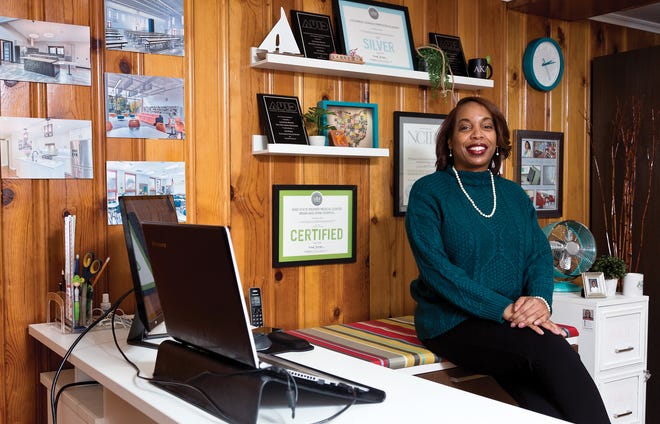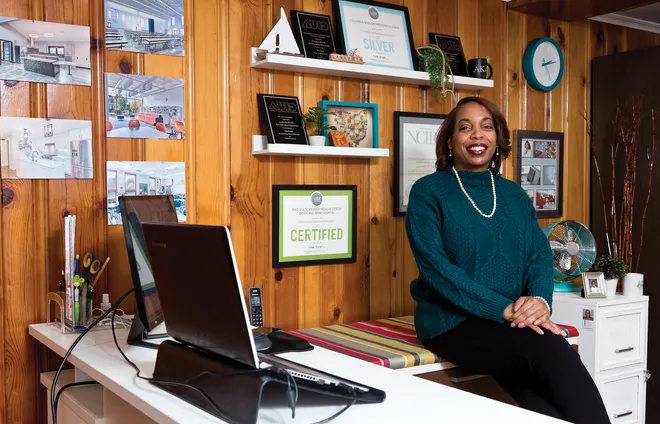Lannetta Knotts is using her Maraye Design Studio to help families succeed during the pandemic.
When database engineer Alain Jean’s Washington, D.C.-based company told him that he would be working from home for the foreseeable future, he did what a lot of people did: He made every room in the house his office.

“I would just stage myself in the bedroom, or on the couch, or in the kitchen,” Jean says. But as the pandemic escalated, Jean and his wife, Rhia, began struggling with the demands of at-home work and their three kids, ages 6, 5, and 3.
“They had to be online, virtually learning,” Jean says. “I was sharing with my children, and we decided we needed something more suitable for long-term remote working.”
That’s when Rhia called on her friend, interior designer Lannetta Knotts, 43, owner of Columbus-based Maraye Design Studio since 2008.
“I had already been thinking about how to shift my focus to work-from-home,” Knotts says. “They hired me on the spot.”
She spent the evening designing processes and pricing for her website.
Since then, Knotts’ sales have increased by 20 percent. And, by offering ergonomic furniture solutions, the firm saw a roughly 30 percent increase in sales in the fourth quarter of 2020. “I believe, with the trend of more employers offering employees the option to stay home permanently, sales will double this year,” she says.
Pre-pandemic design
Prior to opening Maraye, which is Knotts’ middle name, she designed educational spaces for Ohio State University for about a decade, so when she launched Maraye, she focused on education facilities.
She has also worked with restaurants and hotels, updating rooms and dining areas, and helped design Franklin County administrative buildings and courtrooms.
When the pandemic hit and schools and businesses began adopting virtual models, at-home spaces became increasingly important.
“Creating a separate work space at home is crucial to productivity,” Knotts says. “I tell [clients], the kitchen is not your office. The kitchen is a place where you cook a meal and sit down and eat with your family. You don’t want to associate time with your family and work.”
The efficiency and health of the working- and learning-from-home space are also important, Knotts says.
“We put [children] in a hard chair and say, ‘Learn.’ And then you see a child slouching over, not paying attention—they’re sitting in a chair that’s uncomfortable.” Screen positioning also is key, she says. “Ergonomically, your child should not be looking down.”
For Jean, she recommended a sunny yellow paint color and upgraded lighting, plus a dedicated desk and office space.
Originally from Akron, Knotts was raised in a low-income area called The Bottom. “I grew up in the inner city where not very many people went to college,” she says. “No one I knew was an architect. I didn’t know what architecture and design was, but I liked to build things and sketch,” she says.
Those interests took her to Miami University in Oxford, where she earned her degree in interior design. “I got a lot of financial aid and my family put money together to support me,” she says. “My neighbors, my family, friends—everyone was encouraging because they wanted to see someone from our community do better.”
Today, she pays it forward by helping young adults navigate college admissions, and she has used her design skills to help parents of children with learning differences.
“I have a child at home with ADHD,” she says. “I wanted to see how parents were dealing with that, and I was able to share some of the things I had done at home, like placing a red dot where the camera is” to help her child focus.
In Jean’s case, Knotts office updates have certainly helped. “It’s shifted my ability to focus, and I’m more comfortable sitting down at a real desk,” Jean says. “I’m more organized. Definitely my productivity has improved.”
The original story appeared in the March 2021 issue of Columbus CEO magazine.



